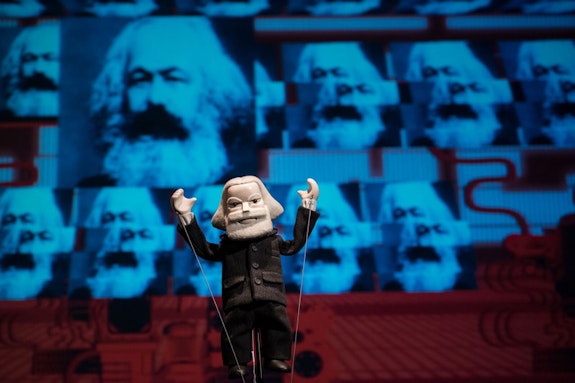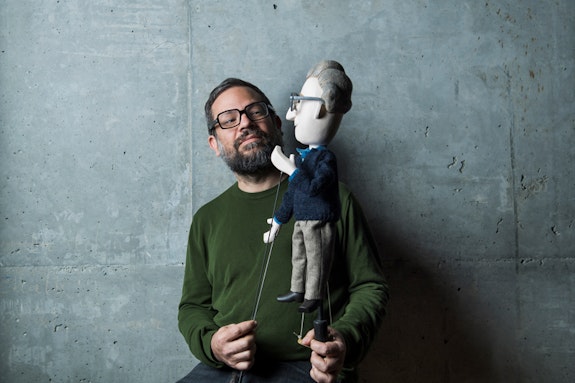Theater In Dialogue
Manufacturing Michief: PEDRO REYES with Torry Bend
I first came across Pedro Reyes's work while researching performance and social activism. I was profoundly struck by his piece Palas por Pistolas (Shovels for Guns), an initiative that began with a city voluntarily turning in guns and ended with school children planting trees with shovels built from the melted down weapons. The process of making this work involved multiple points of performance, reflection, and community engagement and resulted in a sustained process of making that required change in the community for the completion of the project. It seems to me that Reyes makes thoughtful art with big vision. When I learned that he was making puppets I was thrilled— an artist with a heart and a sense of humor using a performance medium I love. I took this opportunity to sit down with Pedro Reyes and talk about his upcoming show.
Torry Bend (Rail): Your work spans many forms: sculpture, immersive performance, architecture, civic engagement, and interactive installation. When did you find puppetry?
Pedro Reyes: The idea to make a puppet show came first out of an exhibition in 2007 in Japan. I had just become a parent, and I realized how stupid all TV for children was. It’s like junk food for the mind. I thought to myself, if kids can memorize 200 names of Pokemon or Star Wars characters, why couldn’t they learn about the main thinkers in history? So I started working with a puppet maker in Kawazaki, who had made puppets for Bunraku. And I entered the world of Japanese puppeteering. My idea was to make a sort of Marxist Sesame Street, which seemed like a totally outdated idea in 2007, but then the financial crisis came and Marx was relevant again.
Rail: You have worked with both playwright Paul Hufker and director Meghan Finn before. In 2016 the three of you created Doomocracy, an immersive installation best described as a haunted house— the work questioned U.S. politics on the eve of the presidential election. How have the events of the last year and a half influenced your collaborative team as you make Manufacturing Mischief?
Reyes: After making Doomocracy, people came back to us saying that now they were living in the haunted house. It’s as if the play had just started as you came out of the theater. We tried to express this at the end of the play, where people had to choose between three doors from where you exit. Those who exited the Trump door were given a Trump mask, those who exited the Hillary door were given a Hillary mask, and those who exited the other door were also given a Trump mask. This was a way to tell our public that if they were voting for Jill Stein or not voting, they were voting for Trump. People did not expect him to win. I knew that there was a very high risk of him winning and wanted to warn people in the play. Now people have told me that they are living in the haunted house even if the play has ended.
Manufacturing Mischief came out of my residency at MIT, where the most advanced research on artificial intelligence and robotics is taking place. However, I keep a critical position to what I call techno-enthusiasm. Reflections on the human costs of automation are rare. Every day thousands of jobs are lost to robots, and at MIT you often see that every project is about how to put a robot where a person is, but there is no one thinking about those workers who are laid off.
I wanted to stage this conflict which has also been a concern of Noam Chomsky, the most famous person at MIT. I went to see him and told him I wanted to do a puppet show with him as a protagonist. Happily, he agreed, and I started working trying to contrast his ideas with those heroes of techno-optimism in the tradition of Henry Ford. Twenty years ago, such a character was Steve Jobs, and today the role of the visionary techno-hero is epitomized by Elon Musk. The problem is that among the very few books that [Musk and Jobs] have read is Ayn Rand, which is an incredibly toxic ideology that praises individualism at the expense of the annihilation of the poor and the weak. Ayn Rand has no currency in academia—anyone would mock you just for bringing her name up. Yet, she has enormous currency, and her books continue to be read. She has been a sort of bible for the Trump administration, so I wanted to address this problem in contemporary ideology, so she became a natural antagonist. I started a research where we were making cross-references of what every character had said of each other. All the quotes where Elon Musk had praised Ayn Rand, or where Noam Chomsky had criticized Elon Musk, etc. Out of this research, we had a lot of material to start writing the script. Paul has an extremely dark sense of humor, and he was great in putting all the parts together. Megan is a fantastic director, who has given life to the puppets in order to make Manufacturing Mischief an extraordinary performance to watch.

Rail: What discoveries have you made about puppetry and/or immersive performance as the three of you explore these different performance forms?
Reyes: Puppets are sort of medieval robots. You can do with them things that actors won’t do so easily. For instance, the puppet of Elon Musk has a face that pops up and reveals that he is an android with blinking lights and electronic parts inside. But this is a trick that is quite ancient. It’s used in Kaidan Bunraku, which are ghost stories from Japan. Puppets allow you to deal with subject matters in an effortless way, since puppets are to a certain extent mono-dimensional. It is not a place to explore the depths of a character as you do with acting, it's more about what the character of the puppet represents. It represents a set of ideas, and that is why it's great to have philosophical debates.
Rail: It seems that your Karl Marx puppet has been a consistent character in your work for a while. Have any of the new characters that show up in this play planted seeds for future work?
Reyes: Marx was the first character to be created and he also has an unchallenged status in the history of philosophy, but in the early productions he had a counterpart with Adam Smith. There were always these hilarious debates between them with endless arguments. This is the beauty of puppets—that they allow you to bring together two characters that didn’t have a chance to meet in real life. Yet, I am very happy to introduce new characters. I’m very proud of how the Chomsky puppet turned out. So far, I have about thirty-five puppets, which become a fantastic “philosophical palette” to stage the conflicts of contemporary thinking, but linking that back to Plato. So I can imagine that in the future there will be other plays and situations where these puppets emerge.
Rail: Where do you find inspiration for new projects?
Reyes: I spend a lot of time in second hand bookshops. It is sort of a meditation for me: I browse the shelves, looking at every single spine in search for oddities. In reality, everything interests me. My library is very diverse, and every month I buy over 100 books. Which means I spend a lot of time rearranging the stacks. This happens between 10pm and 2am, which is a moment where serendipitous findings happen as I am reminded of the interests I had forgotten. So in this way, it is as if I have an endless arsenal of ideas to produce in the future.
Rail: Do you have future projects in the works that you are willing to tell us a bit about?
Reyes: Inspired in Augusto Boal’s method of Legislative Theatre, I made a project called Amendment to the Amendment which is a rewrite of the second amendment. I did it first in Florida after the shooting of Trayvon Martin, and now I am going to do it in Scottsdale, Arizona. This workshop is a sort of massive hackathon where the public produce rewrites of the Second Amendment. The Second Amendment is the Achilles’s heel of the NRA. I am also concerned with this problem, because in order to fix the problem of gun violence in Mexico you have to hack the kind of gun availability in the United States.


